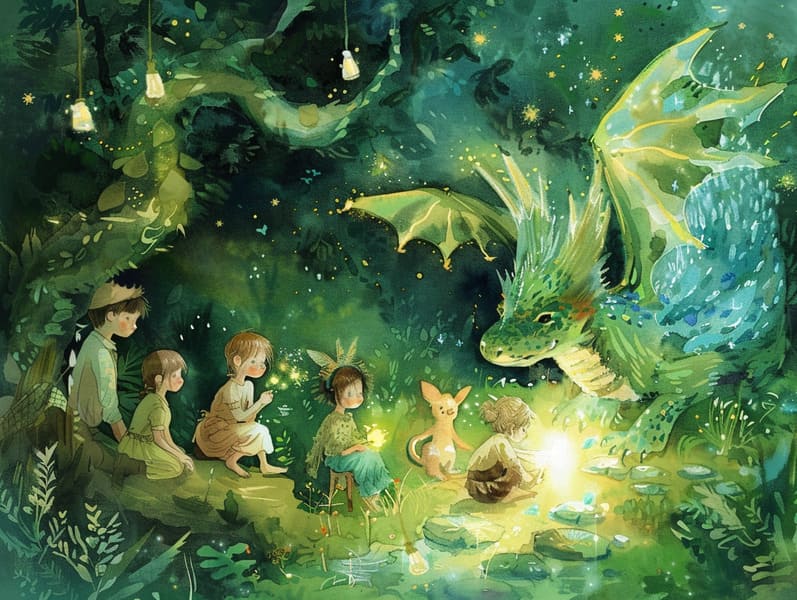
Fairy tales have old origins. These tales have been transmitted from one generation to the next centuries before they were ever transcribed. They emerged from a variety of backgrounds, including Indigenous traditions. They were initially passed along among mature audiences, often carrying themes and messages reflective of the societal norms and beliefs of the time.
The renowned Brothers Grimm, Jacob and Wilhelm (the Grimm brothers), were among the first to collect many of these beloved fairy tales. Their volume, "Grimm's Fairy Stories," included narratives like "The Little Glass Slipper," "The Story of Hansel and Gretel," and "Snow-White and Rose-Red," which have since become classics in the world of beloved fairy tales. Similarly, Hans Andersen's whimsical stories, such as "The Story of the Little Mermaid," and "The Duckling's Story," have touched hearts worldwide, cementing their place in the pantheon of classic fairy tales.
Despite being ancient, traditional fairy tales remain as pertinent as ever, especially as children's night stories. These enchanting tales are now available in numerous formats, including richly illustrated books, delightful animations, and free fairy tales online.
Their lasting appeal can be traced to several whimsical characteristics:
Moral Lessons: Ancient fairy tales often offer important moral lessons. Narratives like "The Shepherd Boy and the Wolf" teach the benefit of honesty, while "The Tale of the Tortoise and the Hare" illustrate the values of persistence and meekness. These narratives offer young readers clear distinctions between right and wrong, developing their moral compass in a subtle yet profound way.
Warmth and Understanding: Timeless fairy tales frequently include beings facing difficulties and adversities, motivating young listeners to connect with their struggles and root for their triumphs. For instance, "The Story of Beauty and the Beast" demonstrates the virtue of seeing inner beauty to know the true being of a being, advancing compassion and recognition.
Cultural Knowledge: Many traditional fairy tales are deeply ingrained in the cultural contexts from which they came. Delving into these tales can provide intriguing perspectives into different ways of life, cultivating a sense of world understanding and appreciation.
Creativity and Imagination: The fantasy-filled elements in fairy tales—enchanted objects—activate children’s creative dreams. These tales bring readers to mythical realms, enlivening imaginative ideas and a sense of enchantment that stays a lifetime.
Traditional fairy tales are not only entrancing but also instructive. They work as fascinating tools in advancing various cognitive and emotional skills in young readers. When classic fairy tales are recited, they cultivate communication skills by offering new lexicon and elaborate sentence structures. This practice also enhances auditory perception and mental focus, as young readers track the narrative, enthusiastic to see what happens next.
Furthermore, analyzing the themes and characters of old fairy tales can strengthen intellectual skills and intellectual skills. Kids learn to pinpoint patterns, predict happenings, and know cause and effect. These explorations also benefit little ones verbalize their thoughts and feelings, enhancing their emotional intelligence.
In today’s online age, the prevalence of online storybooks has made these tales more reachable than ever. Online resources and programs supply large libraries of classic fairy tales that can be read or played anytime, anywhere. Fairy tales voiced are particularly favored, providing an enjoyable way for young ones to relish these bewitching tales. Spoken stories and read-to-me stories carry characters and settings to life, often supported by enchanting sound effects and background music that heighten the story journey.
The timeless appeal of timeless fairy tales lies in their ability to modify to present days while retaining their central messages. Contemporary reinterpretations of these stories often bring in more representative figures and modern settings, making them understandable to today’s audience. However, the key lessons of spirit, benevolence, and fair-mindedness remain unchanged, continuing to affect audiences of all ages.
Old fairy tales also offer a sense of assurance and understanding. They present a ordered narrative with a transparent beginning, middle, and end, often drawing to a close with the resolution of conflicts and the triumph of virtue over wickedness. This certainty can be consoling for kids, providing a sense of steadfastness in an dynamic world.
Old fairy tales continue to fascinate and guide new generations, maintaining their majesty and significance in modern society. As kids' bedtime tales, they make available a perfect blend of charm and enlightenment, encouraging moral values, empathy, and creativity. The prevalence of digital storybooks and the commonness of fairy tales read aloud warrant that these traditional fairy tales remain within reach to new generations.
By conserving and spreading these stories, we continue to value the rich tapestry of myths and cultural heritage. Whether you are click here browsing a artistically illustrated book, viewing a electronic collection, or hearing an read-aloud book, the radiance of old fairy tales is always within reach. These stories teach us of the persistent force of tales and its ability to link us across epochs and places.
No matter if you are seeing a beautifully illustrated book, experiencing a cyber library, or playing an read-aloud book, the spell of Grimm's fairy tales is always within reach.
These stories remind us of the endless presence of fairy tales and its ability to link us across eras and regions, weaving a spell that delights and instructs alike.